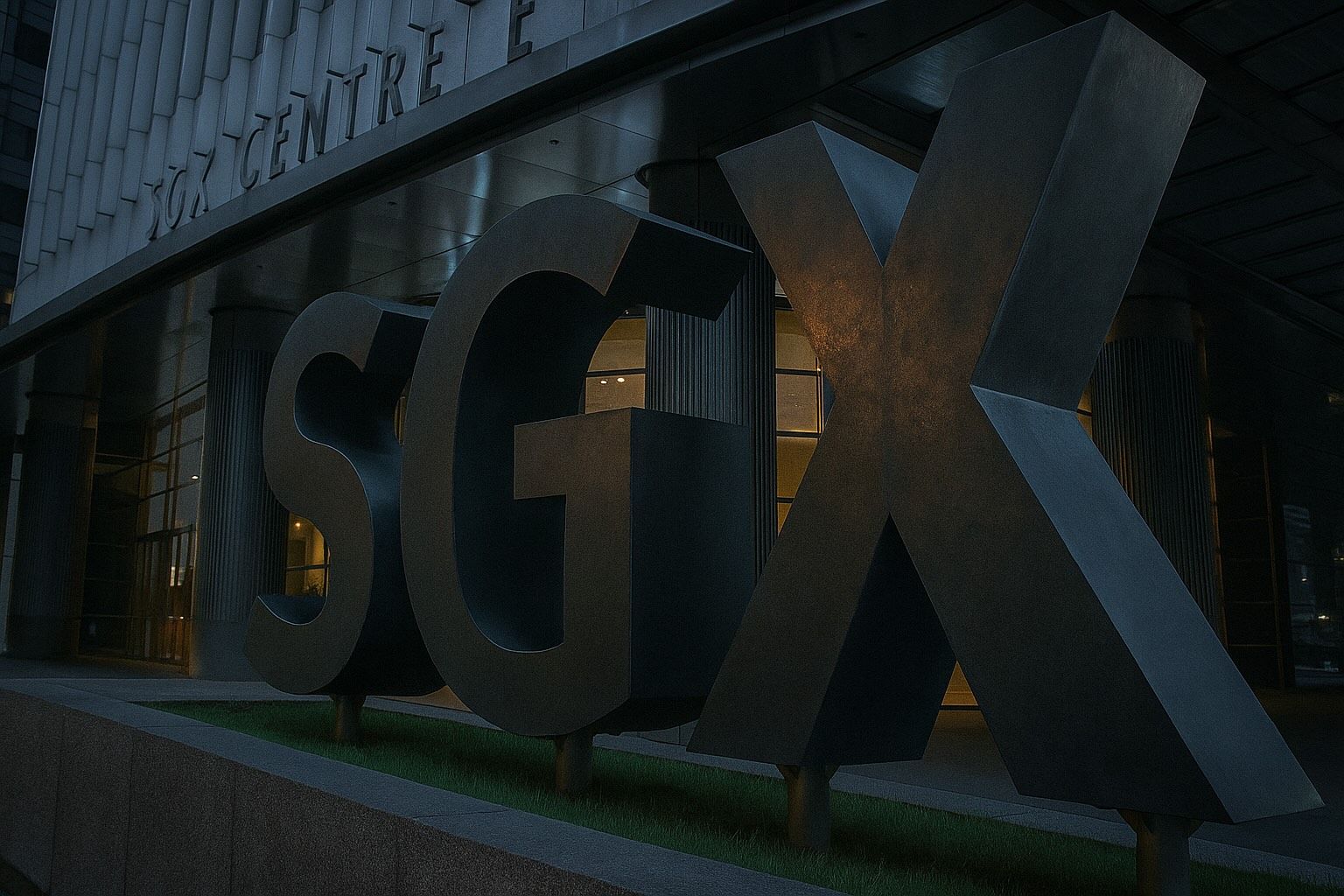- Straits Times Index (STI) Gains: Singapore’s benchmark STI rose about 0.4% (up 15.71 points) on Nov 3 to close at 4,444.33, tracking broad gains across Asian markets [1]. This puts the index near the upper end of its recent trading range around 4,450 [2].
- Market Breadth: Investor sentiment was positive. Advancers outnumbered decliners 348 to 227 on the SGX, with approximately 1.7 billion securities worth S$1.6 billion traded [3].
- Top Movers:Jardine Matheson Holdings led blue-chip gainers, jumping +3.4% (up US$2 to US$60.75) [4]. By contrast, DFI Retail Group was the biggest decliner, down -3.1% (US$0.11 to US$3.40) [5].
- Bank Stocks Mixed: Singapore’s heavyweight banks saw mixed performance. UOB rose +0.5% to S$34.85 and OCBC inched up +0.2% to S$17.07, while DBS slipped -0.3% to S$53.79 [6].
- Regional Rally: The upbeat session came as regional markets rallied. South Korea’s KOSPI surged +2.8% to a record high, Hong Kong’s Hang Seng climbed about +1%, and Australia’s ASX 200 added +0.2%, amid improving risk appetite across Asia [7].
Market Overview: STI and Sentiment
Singapore’s stock market opened the week on a strong note, ending higher on Monday (Nov 3) in line with gains across Asia [8]. The Straits Times Index (STI) closed at 4,444.33 points, marking a 0.4% advance from the previous session [9]. This move reverses Friday’s mild decline and keeps the STI near the top of its recent 4,420–4,450 trading band, indicating resilience but also a still range-bound market [10]. Market breadth reflected bullish sentiment, as advancers outpaced decliners by roughly 1.5-to-1 and turnover was moderate at S$1.6 billion [11]. Traders noted that the broad-based gains signaled renewed risk appetite after a cautious end to October.
Overall sentiment was bolstered by regional optimism and easing global risks. Investors took cues from a rally in major Asian indices, suggesting that Singapore’s market is benefitting from a rotation into regional equities. “Local shares ended Monday higher, tracking gains across regional markets,” The Business Times observed, highlighting that the STI’s rise was part of a broader Asian upswing [12]. This represents a shift from the prior session (Oct 31), when the STI fell 0.2% to 4,428.62 amid profit-taking ahead of key economic data releases [13]. Last Friday’s dip was seen by analysts as “more of a breather than a reversal”, as investors paused a recent rally to await fresh catalysts [14]. By Monday, some of those anticipated catalysts – from global policy moves to trade developments – helped improve risk sentiment, allowing the STI to resume its climb.
Major Stock Movers and Price Data
Blue-chip stocks showed a mix of strong gainers and a few laggards on Nov 3. Conglomerate Jardine Matheson Holdings was the top performer on the STI, surging 3.4% to US$60.75 [15]. Jardine’s rally contributed significantly to the index’s gains, possibly reflecting investor confidence in cyclical and value stocks as global outlook improves. On the other end, DFI Retail Group (formerly Dairy Farm) was the biggest loser, dropping 3.1% to US$3.40 [16]. The retail-focused conglomerate’s decline comes despite the broader market strength, suggesting company-specific factors or cautious consumer sector outlook weighed on its stock.
Among the heavily weighted banking sector, performance was mixed. United Overseas Bank (UOB) rose +0.5% (to S$34.85) and OCBC Bank edged +0.2% higher (to S$17.07), supported by the improved market sentiment [17]. However, DBS Bank dipped -0.3% to S$53.79 [18]. The divergence in bank stocks hints that while lower interest rate expectations globally can lift rate-sensitive sectors (like financials) broadly, stock-specific factors and recent earnings results are still influencing bank share performance individually.
In terms of market activity, telecommunications giant Singtel stood out as the most actively traded STI component by volume. Singtel saw 33.5 million shares traded and ticked up +0.2% to close at S$4.26 [19]. The slight gain followed news that the CEO of its Australian subsidiary Optus will not step down after a major network outage incident, which may have provided some relief to investors concerned about governance or leadership changes [20].
Other notable moves included the broader Jardine group stocks and real estate investment trusts. While not individually cited in news reports, the day’s market breadth (with nearly 350 stocks up) suggests that gains were spread across sectors, from technology and industrials to REITs and consumer plays. The iEdge Singapore Next 50 Index (a mid-cap index) did dip 0.2% on the day [21], indicating that mid-sized stocks slightly lagged the blue chips. Nonetheless, the overall tone was positive, with defensive high-dividend stocks and cyclicals alike finding buyers. This aligns with observations that investors are favoring quality names amid an ongoing tug-of-war between optimism and caution.
Sectoral Performance Analysis
By sector, performance was broadly positive with a few exceptions. The financial sector saw modest gains in two of the three big banks, aiding the STI’s advance [22]. Bank stocks have been navigating the cross-currents of lower interest rate expectations (which can compress lending margins) versus improving economic optimism and robust capital positions. Monday’s mixed bank results suggest the sector is stabilizing after last week’s softness (all three banks had finished slightly lower on Oct 31) [23].
Telecommunications and media got a small boost, exemplified by Singtel’s active trading and uptick [24]. Industrial conglomerates outperformed; Jardine Matheson’s 3.4% jump lifted the multi-industry sector, possibly reflecting confidence in companies with diversified global exposure. Property and REIT counters were mostly steady to slightly higher. Notably, last week property stocks had faced some pressure (on Oct 31, losses in property counters weighed on the STI [25]), but this seems to have abated on Nov 3 as interest rate worries eased.
Consumer-related stocks and retailers were mixed – the sharp fall in DFI Retail Group [26] weighed on the consumer staples sector, suggesting some skepticism around retail earnings or regional consumer demand. On the other hand, selective tech and growth stocks saw interest, continuing a trend from late October when investors rotated into growth plays even as heavyweight value stocks paused [27].
Overall, defensive sectors (like telecoms and REITs) and cyclicals (like industrials and finance) both contributed to the day’s gains. Analysts note that in the current environment, investors are leaning towards defensive, high-yield stocks while remaining selective on growth names, a strategy that has characterized recent sessions [28]. This balanced sector performance underscores a market searching for direction: willing to bid up stocks on good news, but still mindful of external risks.
Key Developments Driving the Market
Several developments in recent days set the stage for Monday’s market performance:
- Profit-Taking Gave Way to Optimism: At the end of last week (Oct 31), Singapore stocks had pulled back slightly as traders locked in profits ahead of key data releases and earnings. The STI’s 0.2% dip on Friday came with a cautious undertone – decliners outpaced gainers and heavyweight bank and property stocks lagged [29]. However, market watchers described that pullback as “a breather rather than a reversal,” expecting the rally to resume if fresh catalysts emerged [30]. Indeed, over the weekend and into Monday, investors received a mix of news that skewed toward the positive, encouraging the STI’s rebound.
- Fed Rate Cut and Policy Signals: A major impetus was the U.S. Federal Reserve’s interest rate decision in the prior week. The Fed cut rates by 25 basis points to 3.75–4.00% in its late-October meeting, marking an ongoing pivot towards easier monetary policy [31]. While Fed Chair Jerome Powell struck a cautious tone about further cuts – citing uncertainty and data dependence for December – the move reinforced the view that global interest rates are now on a downward trajectory [32]. Easier monetary conditions tend to benefit equities, and Singapore’s market is no exception: lower global rates improve liquidity and make high-dividend local stocks more attractive. That said, Powell’s hesitance also kept exuberance in check, aligning with the measured optimism seen in SGX trading.
- Trade War Ceasefire and China Outlook: Geopolitics and trade also played a key role. Last week, U.S. President Donald Trump met Chinese President Xi Jinping in Asia, culminating in an agreement to de-escalate trade tensions [33]. Crucially, Washington and Beijing agreed to a one-year delay on reciprocal tariffs, easing immediate pressure on export-reliant Asian economies [34]. This trade truce lifted sentiment regionally — for example, early in the week of Oct 27, signs of revived US-China trade talks had already given a boost to the STI [35]. By Nov 3, investors appeared encouraged that the worst-case trade war scenarios were off the table for now. However, experts cautioned that the tariff delay “does little to address a deeper divide” between the superpowers [36], meaning trade-related news remains a swing factor for markets.
- China and Regional Economic Data: Fresh data from Asia’s major economies provided a mixed backdrop. Surveys released on Nov 3 showed Asia’s factories struggled in October, reflecting weak export demand and earlier U.S. tariffs [37]. In China, manufacturing activity grew at a slower pace, and an official index showed factory output fell for the seventh straight month [38]. South Korea’s PMI likewise slipped, highlighting regional softness. As a China economist at Capital Economics noted, “the PMIs suggest that China’s economy lost some momentum in October”, and any boost from the latest trade deal is likely to be modest [39]. Despite these headwinds, markets looked past the weak data on Monday, focusing instead on potential policy support. There is speculation that Beijing may introduce further stimulus if needed to ensure it meets its ~5% growth target for 2025 [40]. Investors in Singapore are also watching for domestic indicators – Singapore’s own industrial production figures and corporate earnings due in coming days – which could influence sector rotations [41].
- Corporate Actions and Earnings: On the corporate front, one notable trend is the surge in share buybacks by Singapore-listed companies. The SGX reported on Nov 3 that share buyback spending hit S$1.91 billion in 2025, a 10-year high [42]. Elevated buybacks suggest that many companies see value in their own stocks and are using excess capital to repurchase shares, which can provide a floor under share prices and boost investor confidence. Meanwhile, the Q3 earnings season for Singapore companies has been ongoing. Positive surprises – for instance, Keppel Corporation’s 25% profit rise in Q3 last week – have helped underpin market sentiment amid macro uncertainties [43]. Traders remain alert to any late-reporting blue chips and their guidance, as results could sway specific stock prices and broader sector outlooks.
Expert Commentary and Analyst Opinions
Market experts provided insights into the SGX’s recent performance and underlying drivers:
- Quality Over Hype: Stephen Innes, managing partner at SPI Asset Management, observed that even though many companies are delivering earnings growth, investors are focusing less on headline “beats” and more on the quality and sustainability of earnings [44]. Innes warns that the current market highs might be deceiving, cautioning that “traders know the difference between a cyclical bump and a structural one, and what they’re seeing looks like a plateau dressed as a peak” [45]. This vivid analogy suggests that while stocks have been rallying, some professionals believe the market could be flattening out and may not climb much further without a true structural growth driver. In other words, the STI’s recent gains could be nearing a ceiling unless fundamental conditions improve markedly.
- Rotation to Safety: Earlier in the quarter, analysts pointed out a rotation of funds into Singapore due to global uncertainties. Mr. Isaac Lim, chief market strategist at Moomoo Singapore, noted in late September that the STI’s strength was partly due to “a risk-off play by investors, who are rotating into the more stable Singapore market” amid worries about U.S. political gridlock [46]. Singapore’s reputation as a stable, high-dividend market has indeed drawn investors when global risks (like a potential U.S. government shutdown or geopolitical strife) rise. This theme likely continued into November, with Singapore seen as a relative safe haven in Asia.
- Uptrend as a Bright Spot: Analysts at Phillip Securities Research remain upbeat about Singapore equities. In their Nov 3 morning note, Phillip’s research team highlighted that Singapore’s stock market is in an uptrend, outperforming many other asset classes in October [47] [48]. They stated that “Singapore equities could remain a bright spot, with the uptrend expected to continue” into the rest of November [49]. This bullish outlook is underpinned by factors like easing interest rates, Singapore’s strong fiscal position, and selective strength in sectors like finance and infrastructure. The Phillip analysts also pointed out that global markets – notably the U.S. – are showing signs of consolidation after big tech earnings, whereas Singapore’s market has more room to catch up, supported by its attractive valuations and dividend yields.
- Macro Caution: Economists provide a cautionary macro lens. The Straits Times cited experts noting that Singapore’s economy has been resilient, with Q3 GDP growing 2.9% year-on-year (beating forecasts of ~2%) despite trade headwinds [50]. This resilience is thanks to a domestic construction boom, robust consumer spending, and generous fiscal support from the government [51]. However, there are warnings that external demand remains the wild card. Oxford Economics’ Sheana Yue cautioned that the boost from front-loading exports (shipping goods before tariffs hit) will fade now that higher U.S. tariffs have kicked in, potentially leading to a “payback” drag on future exports [52]. Such insights temper the optimism by reminding investors that the external environment – from U.S. tariffs to China’s slowdown – could cap Singapore’s growth and, by extension, corporate earnings in coming quarters.
Outlook and Forecasts for the Coming Days
Looking ahead, market participants are split between cautious optimism and prudent skepticism. The STI’s firm close on Nov 3 and its sustained position in the mid-4400s suggest that the uptrend has momentum, but the index has yet to break out decisively above the ~4,450 resistance zone [53]. Whether it can do so may depend on new catalysts:
- Near-Term Market Direction: According to Business Today’s weekly market review, the STI has been range-bound and is likely to “remain sideways unless fresh catalysts emerge” [54]. Investors may continue to favor stock-picking (selective names) over broad market moves until a clear driver appears [55]. Key factors to watch in coming sessions include global central bank signals, any further hints of easing or stimulus from major economies, and the next batch of significant Singapore corporate earnings [56]. If any of these surprise positively, they could propel the index out of its range; absent that, a consolidation around current levels is expected, with defensive plays staying in favor [57].
- Economic Indicators on Tap: Traders will be closely monitoring Singapore’s upcoming economic data. Notably, the industrial production figures and PMI readings due shortly could influence sector sentiment [58]. Should Singapore’s industrial output show a rebound, it would reinforce the narrative of a resilient economy and benefit local manufacturers and electronics stocks. Conversely, any disappointment might strengthen the case for continued monetary accommodation. Additionally, U.S. and China economic data (like U.S. jobs reports or China’s trade data) this week could sway global risk sentiment, indirectly impacting Singapore’s market.
- Policy Environment: The macro policy backdrop is turning more stock-friendly. With the U.S. Fed already cutting rates and potentially pausing to assess, and other central banks in the region either easing or on hold, liquidity conditions are supportive. Singapore’s Monetary Authority (MAS) has maintained a neutral stance focused on supporting growth amid benign inflation. The strong Singapore dollar – which some analysts dub the new “king dollar” of stability [59] – helps contain import costs and inflation, giving policymakers room to stay accommodative. Any signals of further rate cuts in the West or stimulus in China would be viewed as positives for risk assets in the near term.
- Market Strategist Views: Optimists like the Phillip Securities team believe the STI’s uptrend will extend, potentially allowing the index to challenge higher highs in the coming weeks [60]. They point to Singapore’s solid fundamentals and its status as a “bright spot” in an otherwise muted global market. On the technical front, some chartists note that if the STI can decisively clear the 4,480–4,500 level, it could open the way for a more significant rally. On the flip side, cautious voices (such as Stephen Innes’s) suggest remaining vigilant. The “plateau dressed as a peak” analogy [61] implies the market could stall. These experts advise watching for any signs of fatigue in the rally or external shocks (for example, a sudden spike in oil prices or geopolitical tensions) that could trigger profit-taking.
- Forecasts: In the coming days, the consensus expects the STI to trade within its recent range, with slight upward bias. If positive momentum from Wall Street and China persists, Singapore’s market could grind higher. However, without a strong catalyst, gains may be incremental. Many analysts foresee volatility around key data releases – such as U.S. inflation or jobs numbers later in the week – which could translate into short-term swings on the SGX. Overall, the tone is one of guarded optimism: the path of least resistance for the STI appears upward, but any advance will likely be measured rather than euphoric.
In summary, Singapore’s stock market on Nov 3, 2025, demonstrated resilient strength, buoyed by regional rallies and improving global sentiment. The STI’s climb of 0.4% came with broad participation, signaling that investors remain confident in Singapore as a haven of stability and growth in Asia. Major stocks like Jardine Matheson and Singtel saw gains, banks stabilized, and market breadth was healthy [62] [63]. Key recent developments – from a Fed rate cut to a US-China tariff truce – have provided tailwinds, even as manufacturing data remind everyone of lingering headwinds [64] [65]. Analysts are actively debating the market’s next move: will the STI break out on renewed catalysts, or will it plateau after this rally? For now, the evidence points to a cautiously positive trajectory. As one research note succinctly put it, Singapore remains a bright spot amid global uncertainties [66], and investors are watching closely to see if that brightness can intensify into a sustained year-end rally on the SGX.
Sources: Singapore Exchange market data and news reports [67] [68]; The Business Times and Straits Times Singapore market analyses [69] [70]; Phillip Securities Research commentary [71]; Reuters and Business Today market wrap insights [72] [73].
References
1. www.businesstimes.com.sg, 2. www.businesstoday.com.my, 3. www.businesstimes.com.sg, 4. www.businesstimes.com.sg, 5. www.businesstimes.com.sg, 6. www.businesstimes.com.sg, 7. www.businesstimes.com.sg, 8. www.businesstimes.com.sg, 9. www.businesstimes.com.sg, 10. www.businesstoday.com.my, 11. www.businesstimes.com.sg, 12. www.businesstimes.com.sg, 13. www.businesstoday.com.my, 14. www.businesstoday.com.my, 15. www.businesstimes.com.sg, 16. www.businesstimes.com.sg, 17. www.businesstimes.com.sg, 18. www.businesstimes.com.sg, 19. www.businesstimes.com.sg, 20. www.businesstimes.com.sg, 21. www.businesstimes.com.sg, 22. www.businesstimes.com.sg, 23. www.poems.com.sg, 24. www.businesstimes.com.sg, 25. www.businesstoday.com.my, 26. www.businesstimes.com.sg, 27. www.businesstoday.com.my, 28. www.businesstoday.com.my, 29. www.businesstoday.com.my, 30. www.businesstoday.com.my, 31. www.poems.com.sg, 32. www.poems.com.sg, 33. www.straitstimes.com, 34. www.straitstimes.com, 35. www.businesstoday.com.my, 36. www.straitstimes.com, 37. www.straitstimes.com, 38. www.straitstimes.com, 39. www.straitstimes.com, 40. www.straitstimes.com, 41. www.businesstoday.com.my, 42. www.businesstimes.com.sg, 43. www.businesstoday.com.my, 44. www.businesstimes.com.sg, 45. www.businesstimes.com.sg, 46. www.straitstimes.com, 47. www.poems.com.sg, 48. www.poems.com.sg, 49. www.poems.com.sg, 50. www.straitstimes.com, 51. www.straitstimes.com, 52. www.straitstimes.com, 53. www.businesstoday.com.my, 54. www.businesstoday.com.my, 55. www.businesstoday.com.my, 56. www.businesstoday.com.my, 57. www.businesstoday.com.my, 58. www.businesstoday.com.my, 59. www.businesstimes.com.sg, 60. www.poems.com.sg, 61. www.businesstimes.com.sg, 62. www.businesstimes.com.sg, 63. www.businesstimes.com.sg, 64. www.straitstimes.com, 65. www.straitstimes.com, 66. www.poems.com.sg, 67. www.businesstimes.com.sg, 68. www.businesstimes.com.sg, 69. www.businesstoday.com.my, 70. www.straitstimes.com, 71. www.poems.com.sg, 72. www.straitstimes.com, 73. www.businesstoday.com.my










